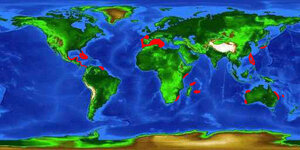- Joined
- Oct 19, 2003
- Messages
- 3,111
For those with an interest to study the book of Jonah, I would also advise looking up the the Myth of Heracles rescuing Hesione. Please find this handy introduction mostly taken from the Rutgers site (edited for errors):
"Heracles's rescue of Hesione, paralleled by Perseus's rescue of Andromeda, is clearly derived from an icon common in Syria and Asia Minor: Marduk's conquest of the Sea-monster Tiamat, an emanation of the goddess Ishtar, whose power he annulled by chaining her to a rock. Marduk is swallowed by Tiamat, and disappears for three days before fighting his way out. So also, according to a Hebrew moral tale apparently based on the same icon, Jonah spent three days in the Whale's belly; and so Marduk's representative, the King of Babylon, spent a period in demise every year, during which he was supposedly fighting Tiamat. Marduk's or Perseus's white solar horse here becomes the reward for Hesione's rescue. Heracles's loss of hair emphasizes his solar character: a shearing of the sacred king's locks when the year came to an end, typified the reduction of his magical strength, as in the story of Samson. When he had no more hair than an infant."
This might also be helpful, Cindy.
Have fun,
Olaf
"Heracles's rescue of Hesione, paralleled by Perseus's rescue of Andromeda, is clearly derived from an icon common in Syria and Asia Minor: Marduk's conquest of the Sea-monster Tiamat, an emanation of the goddess Ishtar, whose power he annulled by chaining her to a rock. Marduk is swallowed by Tiamat, and disappears for three days before fighting his way out. So also, according to a Hebrew moral tale apparently based on the same icon, Jonah spent three days in the Whale's belly; and so Marduk's representative, the King of Babylon, spent a period in demise every year, during which he was supposedly fighting Tiamat. Marduk's or Perseus's white solar horse here becomes the reward for Hesione's rescue. Heracles's loss of hair emphasizes his solar character: a shearing of the sacred king's locks when the year came to an end, typified the reduction of his magical strength, as in the story of Samson. When he had no more hair than an infant."
This might also be helpful, Cindy.
Have fun,
Olaf


